
 |
|
#31
|
||||
|
||||
|
We tend to share the "final" design in many of these postings. Here are some earlier backstrip mock-ups that we were working through. I thought it would be interesting to share ideas that we did not choose as well. Since the Cocobolo back set has light colored sapwood we explored variations that ranged in contrast:
Low contrast boxwood strips with bloodwood square accents:  Medium contrast with the addition of some fine ebony strips: 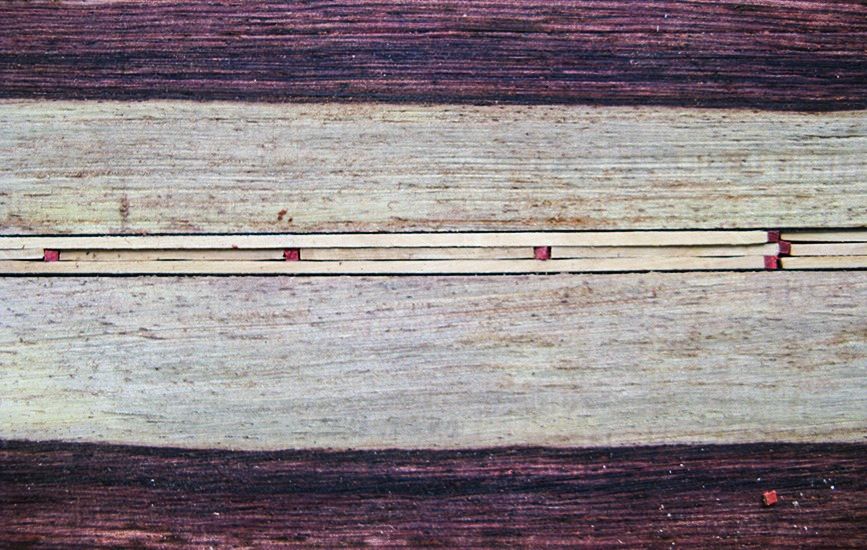 High contrast with thicker ebony strips (the one that we chose): 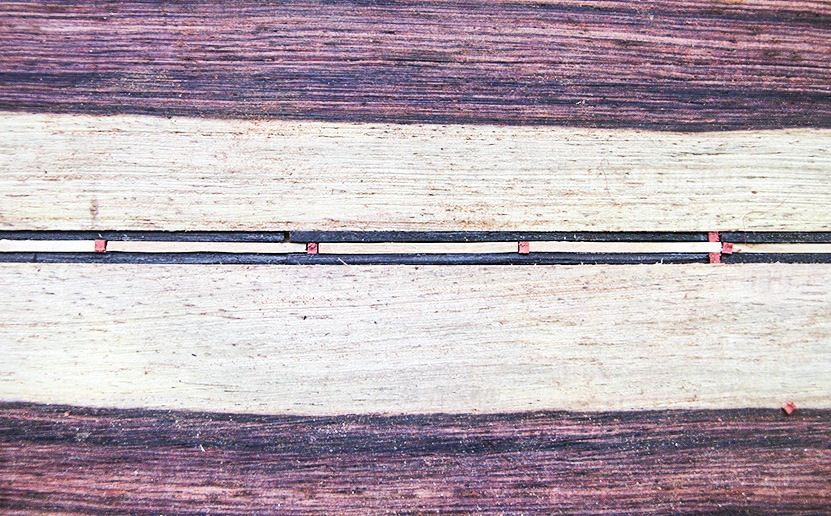
__________________
A bunch of nice archtops, flattops, a gypsy & nylon strings… |
|
#32
|
||||
|
||||
|
Many of the decorative ideas that you will see incorporated in this design come from Bernie's recent visit to the Roycroft Inn (E. Aurora, NY).
For example, some of the bloodwood red square accents used throughout the design have their origin in some ceramic designs: 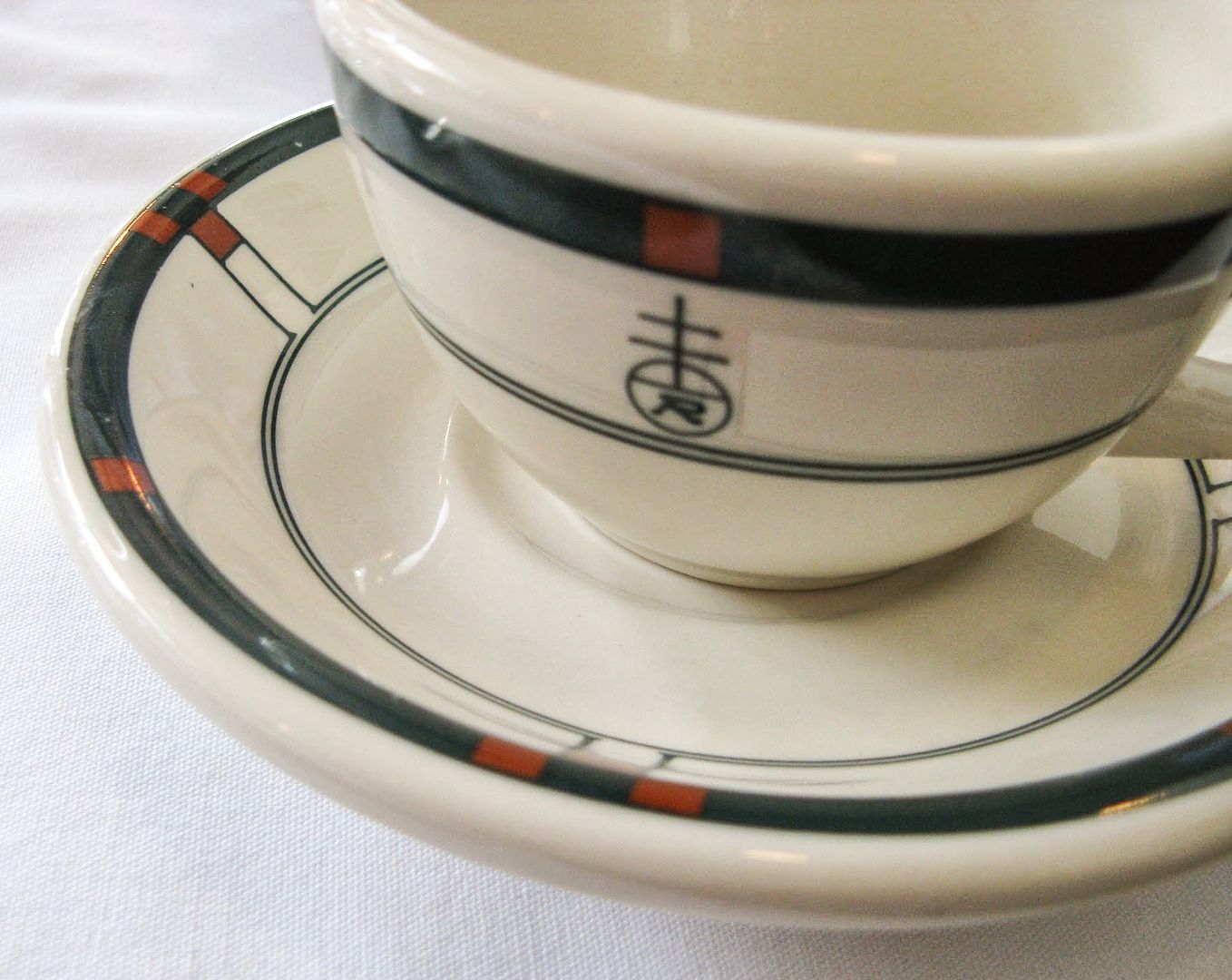 Some of the elements that you may see in the rosette may incorporate simplified tulips as seen in this stained glass design: 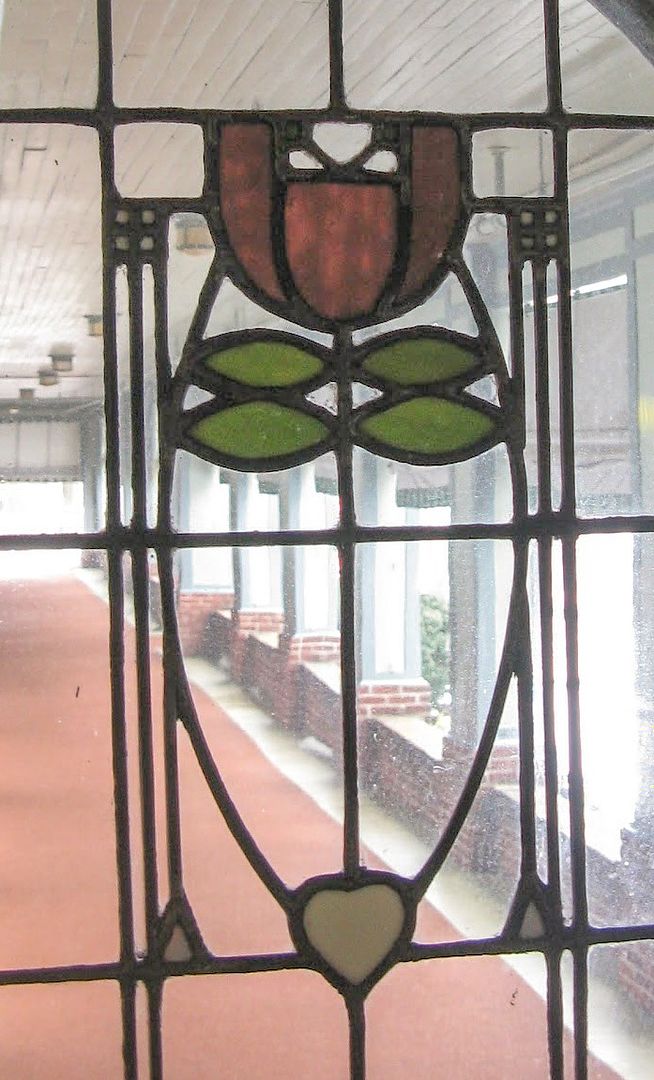 The use of Dard Hunter Roses and Glyphs as seen here in the sign may show up as well. 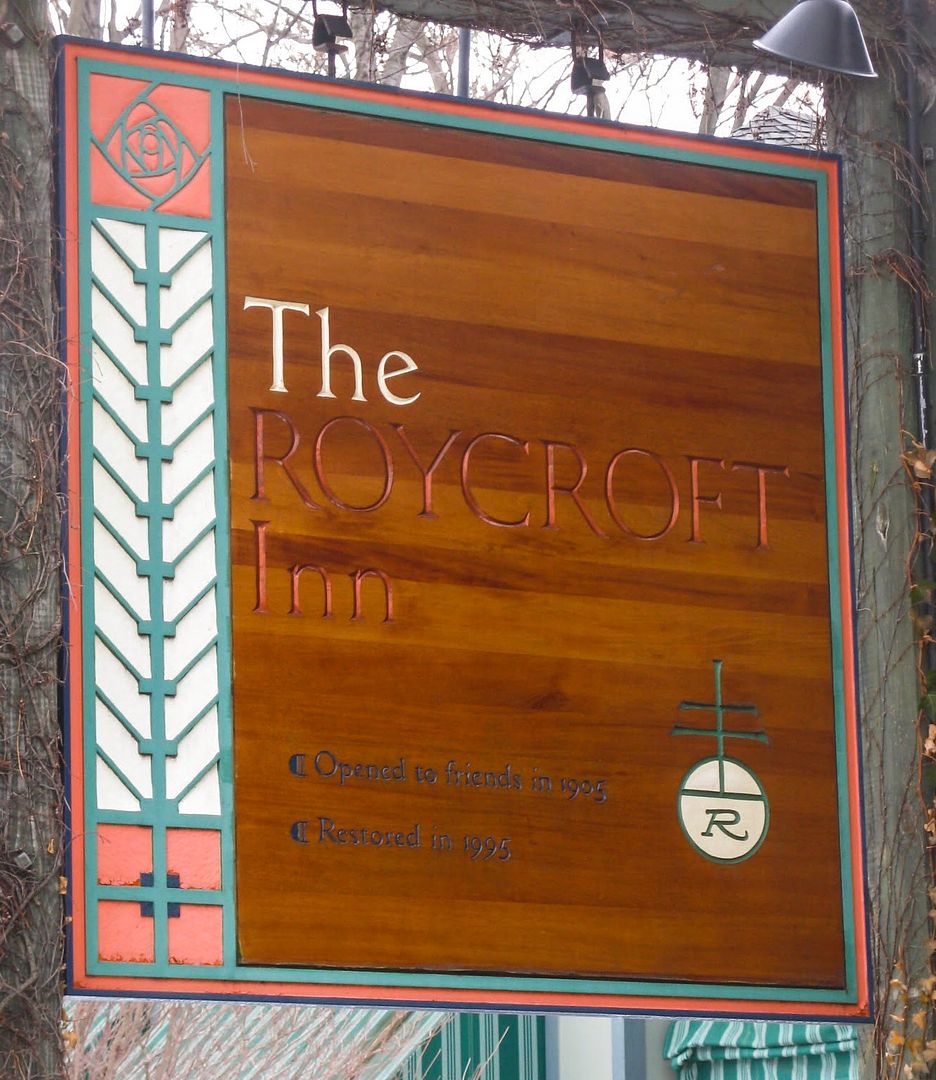 Having a regionally located luthier go out on research trip to actually origin of the design movement at the start of a commision is as good as it gets.
__________________
A bunch of nice archtops, flattops, a gypsy & nylon strings… |
|
#33
|
||||
|
||||
|
Here are a few additional concept sketches for the headplate, tailpiece and fingerboard. The concepts where refined based on luthier/client discussions, so you'll see some differences as the guitar evolves. But the journey on how a guitar achieves its final form is sometimes interesting to understand.
Here's an early sketch of the headplate veneer. We are thinking of an ebony veneer with an engraved ivory "LEHMANN" logo. A light colored accent line in boxwood interrupted by bloodwood squares runs between the two slots in the peghead.  Bernie's tailpiece design is ebony over brass and is shaped to reflect the headstock geometry. A "BL" glyph based upon the Roycroft logo in pierced pearl may be used. 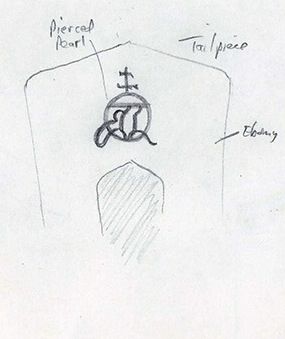 The square accents may also be used to create fret markers on an ebony fingerboard. 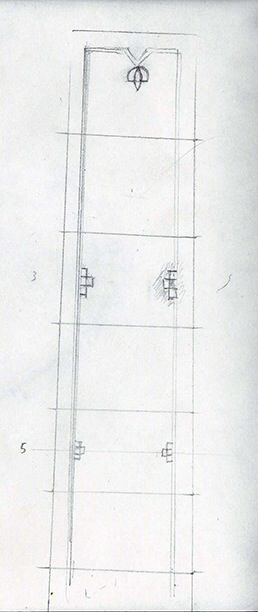 An upper bout sound port based upon a Dard Hunter rose pattern may be cut into the Cocobolo side. 
__________________
A bunch of nice archtops, flattops, a gypsy & nylon strings… |
|
#34
|
||||
|
||||
|
Here are the Carpathian Spruce top plates being joined on Bernie's go-bar deck. Look at the height of the go-bar deck. It has to be >6' tall!
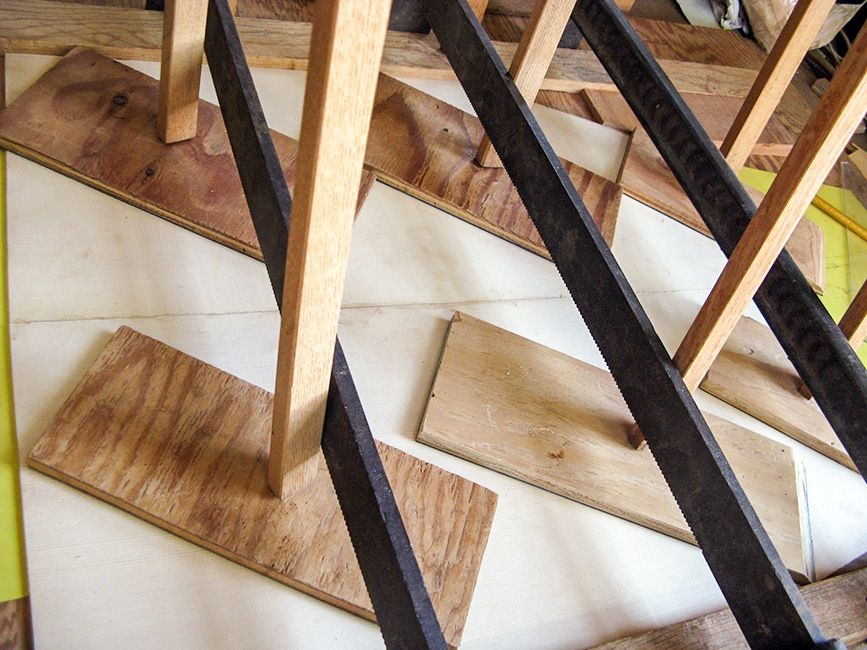  The Cocobolo sides are glued to the neck and tail blocks and are held in form by a simple interlocking frame. The sides are sitting on a dish mold with sandpaper adhered to it. The sides will be sanded until they fit the dish perfectly. The dish has the same curvature as the back and top. Once the kerfed linings are glued on the sides they will also be sanded to fit the arch. 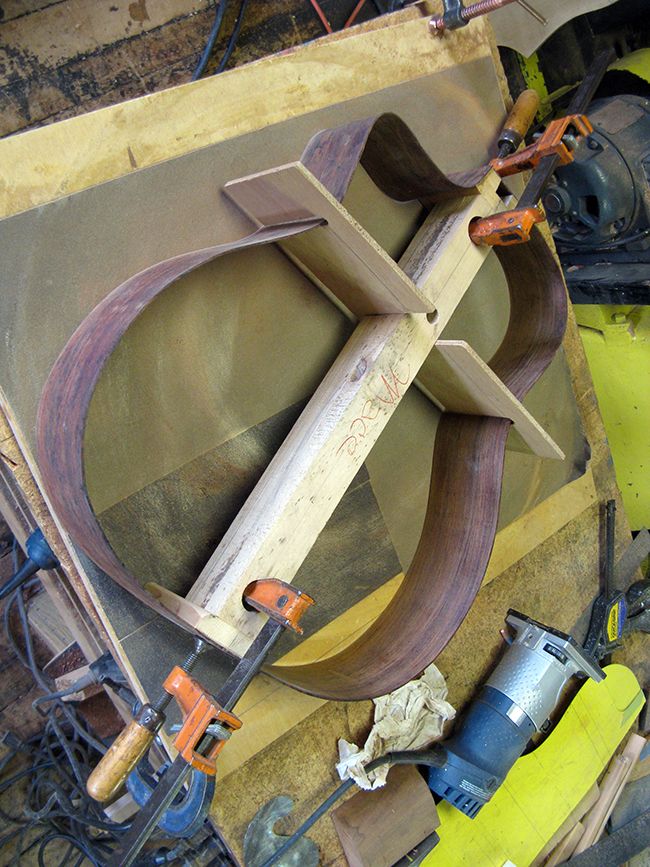 A white oak panel for the sound hole rosette has been glued up and a maple center line has been inlaid. Bernie used a D-shaped jig and a router with template guides of different sizes to cut the groove in the spruce top, the center line and the soundhole itself. The pieces to be inlaid are set out on the drawing. The bloodwood squares will be inlaid showing their end grain because it is the darkest and most even color.  Here is Bernie using a 1/32" router bit in the Dremel tool to create these tiny inlays. After they are "roughed out" with the router, he uses an Exacto knife to clean up the corners. Those tulip leaves are extremely small but the boxwood cuts cleanly and holds the sharp points very well. 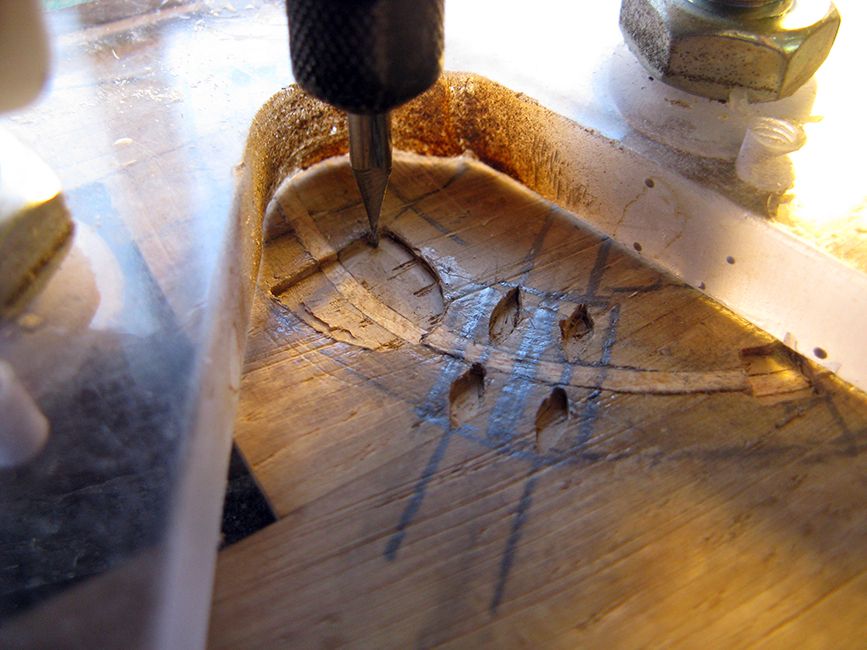 Here is the sound hole inlay with a light finish applied to help keep it clean and show off the woods. The tulips left and right have saw cut lines that will be finished later with an engraver when the rosette has been inlaid in the spruce top. The Dard Hunter rose in the center can't be inlaid until the ring has been set in the top because it will need to be slightly inset into the spruce too. The subtle color differences between the oak, boxwood and maple are seen in much Roycroft work and is one of its' hallmarks. 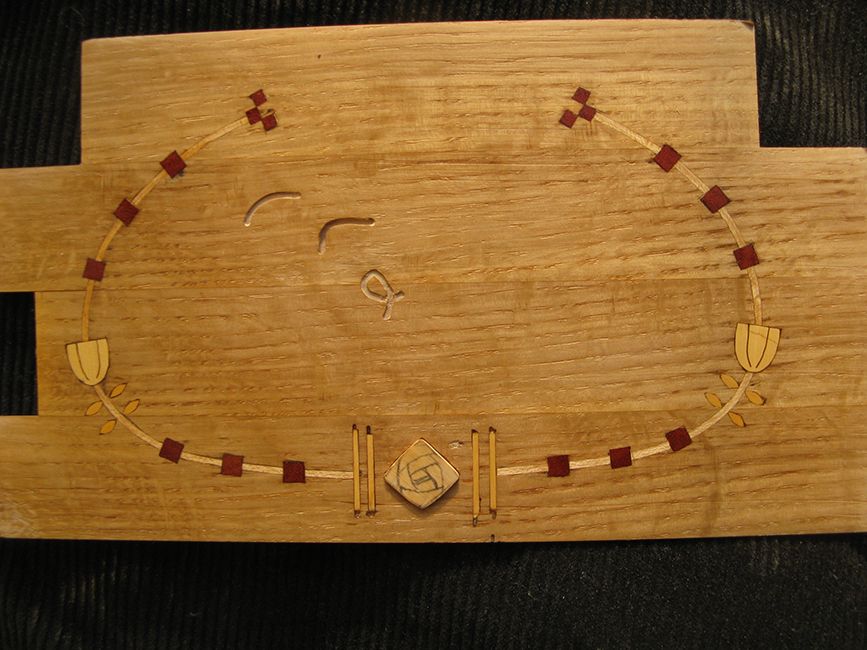 Here's the ebony-boxwood-ebony backstrip with bloodwood accents. 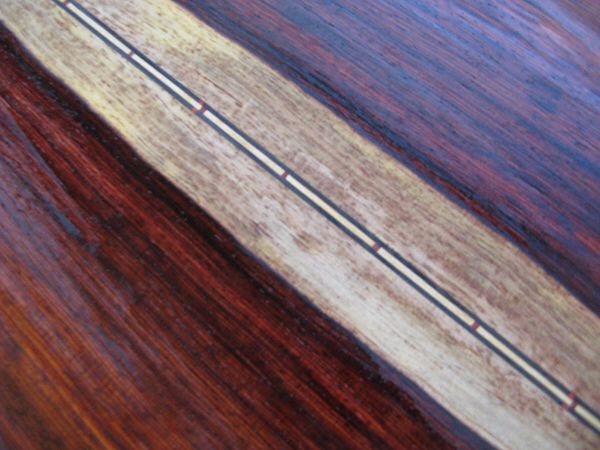 More when I get it...
__________________
A bunch of nice archtops, flattops, a gypsy & nylon strings… Last edited by iim7V7IM7; 05-07-2014 at 11:42 AM. |
|
#35
|
||||
|
||||
|
Bernie adjusted the soundboard thicknessed today. His theory on the gypsy soundboards is that they should be treated like an arch top guitar. They are thicker around the bridge and get thinner towards the edges. The bracing profiles will reinforce this principle. The top acts like a trampoline with the springs around the edges. An instrument like a gypsy guitar, an arch top guitar or a violin that all have floating bridges and tailpieces transfer energy from the strings to the top primarily perpendicularly through the bridge. An instrument with a glued on bridge that also anchors the strings like a flat top guitar transfers the vibration to the top mainly by a torquing action. The stresses are quite different on the two instruments. This uni-directional driving force of the bridge is the main reason these guitars sound differently than flat tops.
This is Bernie's "don't slip" ring jig. The router is set up with a 1/2" bit and router template guide for making the inlay groove. The inlay is set ~2/3 of the way through the thickness of the top. 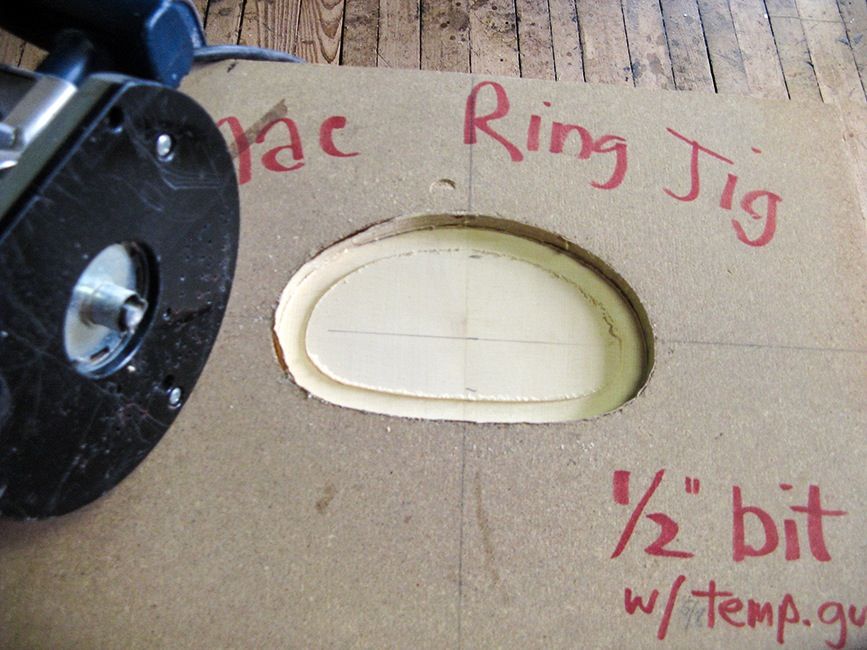 The template guide has a wooden ring set around it to cut the soundhole.  The white oak rosette has been fit into the d-hole shaped pocket and glued in place with the persuasive help of the go-bar deck. 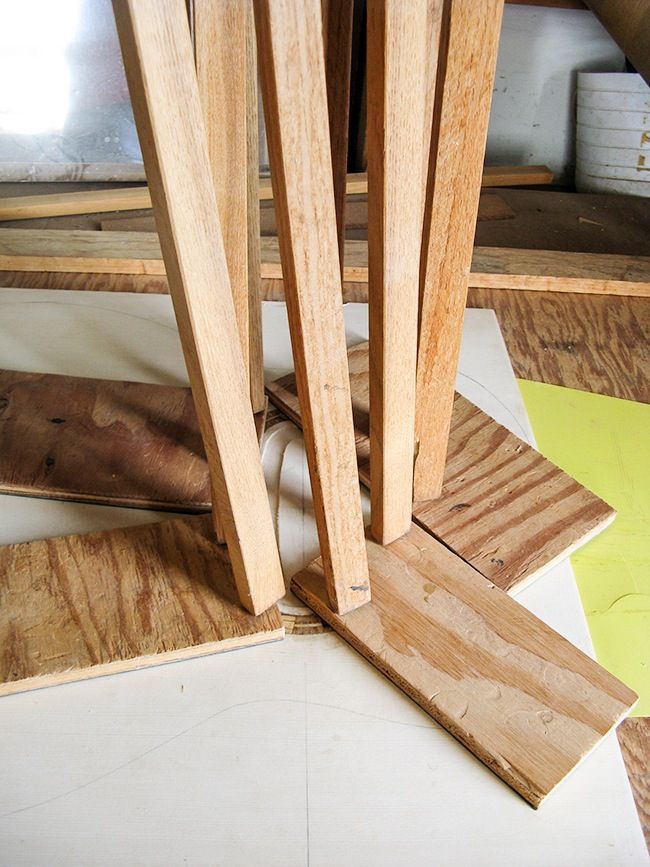 The kerfed linings are made of Spanish cedar are being glued to the sides and held in place with spring clamps until they dry. 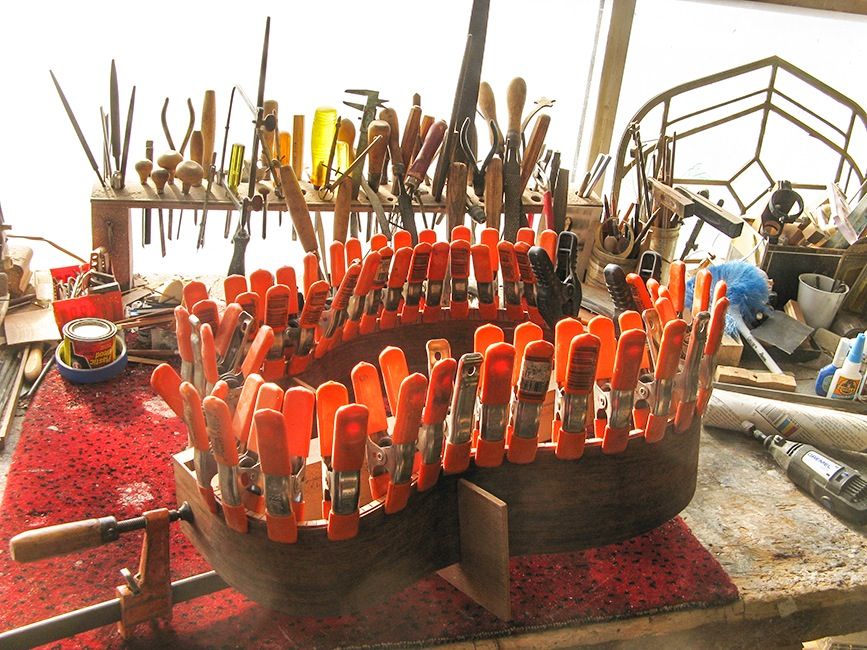
__________________
A bunch of nice archtops, flattops, a gypsy & nylon strings… |
|
#36
|
||||
|
||||
|
Very cool ideas on this one and looking great. Glad to see it here on the Custom Shop. Thank you!

__________________
Home Texas : Time to Ride : Real Nice Day : Make Things Right : For Dreams : YouTube : Spotify |
|
#37
|
||||
|
||||
|
My pleasure J.R....
It is nice to introduce to AGF a less posted, but talented luthier who builds a variety of stringed instruments beyond flat top guitars. Bernie has remarkably made >400 instruments (flat tops, gypsies, classicals, archtops, basses, fiddles lutes etc.) over the last 40-years. He brings all of these diverse instrument making experiences and perspectives to his guitars. He also happens to be a heck of a nice guy to work with. Gypsy guitars for those of you that have neither played them are a joy to play and bring out the Django in a player. The Argentine style strings feel "slinky" and and the midrange punchiness falls between an archtop and flat top in its timbre. Bernie being the non-conventional guy that he is, brings aspects of flat top construction to the traditional Selmer- Maccaferri design to provide some rich overtones to the instrument. This instrument should fit beautifully tone wise between the flat top that Kent is making for me and my archtop that Bill Comins made for me.
__________________
A bunch of nice archtops, flattops, a gypsy & nylon strings… |
|
#38
|
|||
|
|||
|
This is very cool. I have a Saga D-Hole model which I use for fingerstyle jazz. The selmer design is capable of more than gypsy jazz/ I love Lehman's approach. beautiful guitar
|
|
#39
|
||||
|
||||
|
I am glad that you think that its "cool" (I do as well, but hey, I'm biased).
I actually don't play in a strict gypsy style at all either. I play more in a solo jazz standard chord melody arrangements with a plectrum/pinch n claw style. I just like the feel and timbre of a gypsy guitar. I suspect other folks would like them if they tried them as well for a number of styles. What I like about Bernie's take on these instruments is he marry's many aspects that I like from flat tops into his builds and eliminates many traditional features of gypsy guitars that I don't like. I also like his traditional "wabi-sabi", hand craftsmanship approach to building instruments vs. much of the cnc/laser cut perfection that we are used to today.
__________________
A bunch of nice archtops, flattops, a gypsy & nylon strings… |
|
#40
|
||||
|
||||
|
Bernie inset two 1/32" bands of white oak on the inside and outside of the rosette to help bind and define the edges. The boxwood Dard Hunter rose has been engraved and one of the tulips has been filled with engravers wax to show the form. He will fill them after the final sand has been done.
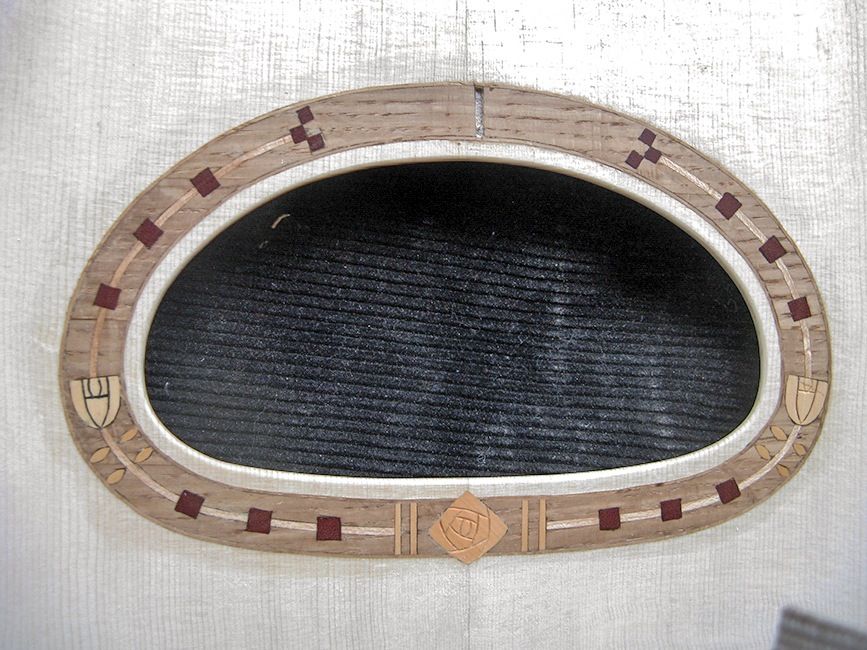 These are Bernie's engravers. He usually uses them on pearl, ivory, or metal but the boxwood works well because it is so dense and has an even consistency. The graver on the left has a "U" shaped tip for a medium wide line; the second is a Diamond Point for making lines that vary in width (by tipping it right or left as the stroke is done; the third is a multiple line graver that cuts 5 lines at once for shading; the far right is a knife edge for very fine lines.  This is an example of pearl engraving on an A.C.Fairbanks banjo reproduction that Bernie made. 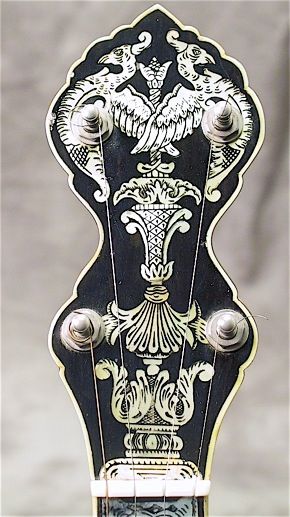 The brace wood is as important as the top wood for good tone. 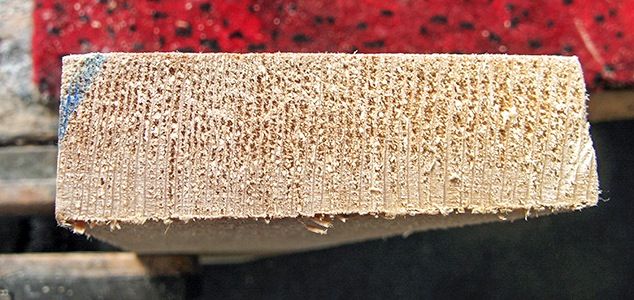 This is Bernie's "easy" brace cutting jig to cut the interlocking joints for the Double X top braces. (12-page instruction manual not shown). 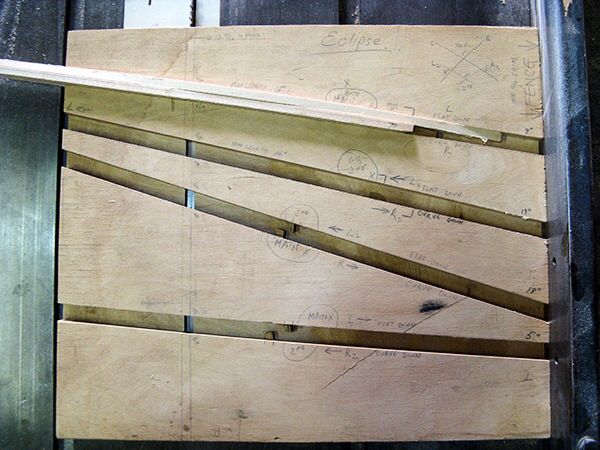 The top braces are cut to a ~18 ft. arc to form the dome on the top and sanded smooth in the radius dish. He couldn't recall the exact radius that he made it to, but it measures 1/2" depth over 24" span. The two crossing points of the braces correspond to the bridge location. Bernie skews all the braces to create areas between the braces of uneven sizes. He believes that this helps a greater variety of overtones to develop. Conversely, ladder bracing encourages a dry and strongly fundamental tone. His only proof is empirical.  Bernie has installed cross grained veneer is glued inside where the sound port will be cut in the upper bout. 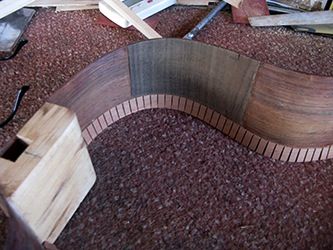
__________________
A bunch of nice archtops, flattops, a gypsy & nylon strings… |
|
#41
|
|||
|
|||
|
Quote:
I've been a long time bassist. I have a few Rob Allen semi-acoustics, but I'd love to make room for something like this if I had more space, more money, and permission from the wife. 
|
|
#42
|
||||
|
||||
|
It might not be as costly as you think...It's worth a phone call to Upstate NY...
 http://www.lehmannstrings.com/index.htm
__________________
A bunch of nice archtops, flattops, a gypsy & nylon strings… |
|
#43
|
|||
|
|||
|
Quote:

|
|
#44
|
|||
|
|||
|
Just want to say again how much I like this thread. The Sel-Mac style is really unique and has some wonderful tonal properties that get overlooked by the rush of Django imitators. I mean, I love Django, but there's no need for slavish imitation. My gitane d-hole sits in this really interesting space between archto/flattop and classical, but it's wearing out. I've contacted Bernie about possibly ordering one myself.
I do notice that this thread is more than a year old--how long does it typically take to have a guitar built? |
|
#45
|
||||
|
||||
|
I was in the same position as you in that I used to have a Gitane DG-370 and really enjoyed playing this style of guitar. Lead time with luthiers can always vary. I placed my order back around Labor Day (end of Aug '013) and Bernie began my build about 8 months later in Apr '014. The build itself seems to happen quite quickly. I suspect that I will have my guitar <10 months after placing an order which is not too bad for a custom build. I suggest that you reach out to him and discuss it with Bernie. His backlog might be shorter, the same or longer.
Quote:
__________________
A bunch of nice archtops, flattops, a gypsy & nylon strings… Last edited by iim7V7IM7; 05-12-2014 at 03:13 PM. Reason: < vs. > |